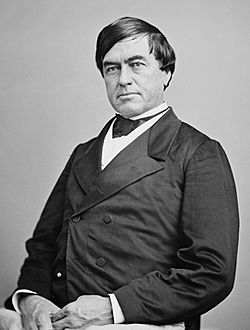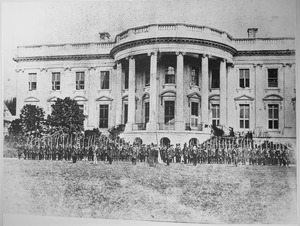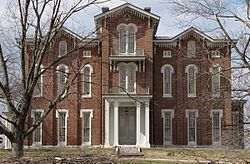Cassius Marcellus Clay (politician) facts for kids
Quick facts for kids
Cassius Marcellus Clay
|
|
|---|---|
 |
|
| United States Ambassador to Russia | |
| In office May 7, 1863 – October 1, 1869 |
|
| President | Abraham Lincoln Andrew Johnson Ulysses S. Grant |
| Preceded by | Simon Cameron |
| Succeeded by | Andrew G. Curtin |
| In office July 14, 1861 – June 25, 1862 |
|
| President | Abraham Lincoln |
| Preceded by | John Appleton |
| Succeeded by | Simon Cameron |
| Member of the Kentucky House of Representatives |
|
| In office 1835–1841 |
|
| Personal details | |
| Born | October 19, 1810 Madison County, Kentucky, U.S. |
| Died | July 22, 1903 (aged 92) Madison County, Kentucky, U.S. |
| Political party | Republican (1854–1870; 1884–1903) Liberal Republican (1870–1872) Democratic (1872–1884) |
| Spouses | Mary Jane Warfield (1833–1878, divorced) Dora Richardson (1894–1897, divorced) |
| Children | Elisha Warfield Clay Green Clay Mary Barr Clay Sally Clay Laura Clay Brutus J. Clay II Anne Clay David Kevin Clay (adopted) |
| Alma mater | Transylvania University Yale College |
| Occupation | Lawyer, politician, newspaper publisher, soldier, farmer |
| Known for | Southern abolitionist and U.S. ambassador to Russia |
| Signature | |
| Military service | |
| Branch/service | 1st Kentucky Cavalry |
| Years of service | 1846–1847 1861–1863 |
| Rank | |
| Battles/wars | Mexican–American War American Civil War |
Cassius Marcellus Clay (born October 19, 1810 – died July 22, 1903) was an important American politician and activist. He was known as the "Lion of White Hall". Clay was a Kentucky planter who strongly supported the end of slavery. He helped start the Republican Party in Kentucky. Later, President Abraham Lincoln chose him to be the U.S. minister (like an ambassador) to Russia. Many people believe Clay helped Russia support the Union during the American Civil War.
Contents
Early Life and Education
Cassius Marcellus Clay was born into a wealthy family in Kentucky. His father, Green Clay, was a rich planter and slave owner. Cassius was one of six children who grew up.
His family was very influential in politics. His older brother, Brutus J. Clay, also became a politician. Cassius was a cousin of famous politicians like Henry Clay and Clement Comer Clay.
Clay went to Transylvania University and then graduated from Yale College in 1832. While at Yale, he heard a speech by William Lloyd Garrison, a famous abolitionist. This speech deeply inspired Clay to join the movement against slavery. He believed in making changes to end slavery slowly through laws, rather than ending it immediately.
Family Life
In 1833, Clay married Mary Jane Warfield. She was the daughter of a doctor from Lexington, Kentucky. They had ten children together, and six of them lived to adulthood. Their children included Mary Barr Clay and Laura Clay, who later became important women's rights activists.
Early Political Career
Cassius Clay was one of the few wealthy Southern planters who fought against slavery. He worked to end slavery as a state representative in Kentucky. He also helped create the Republican Party.
Clay was elected to the Kentucky House of Representatives three times. However, he lost support in Kentucky because of his strong anti-slavery views. His activism made him many enemies. In 1843, during a political debate, someone tried to shoot him. Luckily, the bullet hit the silver tip of his Bowie knife scabbard, which was over his heart. This saved his life.
In 1845, Clay started an anti-slavery newspaper called True American in Lexington, Kentucky. He quickly received threats and had to protect his office with armed guards and even cannons. A group of about 60 men broke into his office and took his printing equipment. To keep his newspaper going, Clay moved its printing to Cincinnati, Ohio. This city was a center for abolitionists in a free state. But Clay continued to live in Kentucky.
Clay fought in the Mexican–American War as a captain from 1846 to 1847. He was against the annexation of Texas because he did not want slavery to spread. However, he volunteered to fight when Mexico tried to take back Texas. In 1849, while giving a speech about ending slavery, Clay was attacked by six brothers. He fought them off and, using his Bowie knife, killed one of them.
In 1853, Clay gave 10 acres of his land to John Gregg Fee. Fee was an abolitionist who founded the town of Berea. In 1855, Fee started Berea College, which welcomed students of all races. Clay was a close friend of Abraham Lincoln. He supported Lincoln for president in 1860. Clay was even considered for vice president at the 1860 Republican National Convention.
Civil War and Minister to Russia
President Lincoln appointed Clay as the U.S. Minister to Russia on March 28, 1861. This was just before the American Civil War began. At that time, there were no federal troops in Washington, D.C. Clay quickly organized 300 volunteers to protect the White House and the U.S. Naval Yard from a possible attack by Confederate forces. These volunteers were known as Cassius M. Clay's Washington Guards. President Lincoln gave Clay a special Colt revolver to thank him. Once federal troops arrived, Clay and his family left for Russia.
While in Russia, Clay saw the Tsar's emancipation edict. This was a law that freed the serfs (farm workers tied to the land) in Russia.
During the Civil War, Russia supported the Union. They even threatened to go to war against Britain and France if those countries officially recognized the Confederacy. Cassius Clay played a big part in getting Russia's help. Emperor Alexander II of Russia sent his Atlantic and Pacific fleets to the East and West coasts of America. Their secret orders were to be opened only if Britain and France joined the war on the side of the Confederacy.
In 1862, Lincoln called Clay back to the United States. He offered Clay a commission as a major general in the Union Army. Clay publicly said he would not accept the rank unless Lincoln agreed to free slaves in Confederate areas. Lincoln then sent Clay to Kentucky to see how people felt about freeing slaves there and in other border states. After Clay returned to Washington, D.C., Lincoln issued the Emancipation Proclamation in late 1862. This important document freed slaves in the Confederate states starting in January 1863.
Clay resigned his military commission in March 1863 and went back to Russia. He served there until 1869. He was also important in the talks for the purchase of Alaska from Russia.
Later Years
After his time in Russia, Clay founded the Cuban Charitable Aid Society. This group helped the Cuban independence movement led by José Martí. Clay also spoke out for nationalizing (government control of) railroads. He later spoke against the growing power of big business owners.
Clay left the Republican Party in 1869. He did not agree with how the Republican Radicals handled the reconstruction of the South after Lincoln's death. In 1872, Clay helped organize the Liberal Republican movement. He helped get Horace Greeley nominated for president. In the presidential elections of 1876 and 1880, Clay supported the Democratic Party candidates. He rejoined the Republican Party for the 1884 election.
Cassius Clay was known as a strong and determined person. Because of threats to his life, he often carried two pistols and a knife for protection. He even had a cannon to guard his home and office. At the 1890 Kentucky Constitutional Convention, Clay was chosen as the President of the Convention. Cassius Clay died at his home on July 22, 1903. His daughters, Laura Clay and Mary Barr Clay, who were both important women's rights activists, survived him.
Legacy
His family home, White Hall, is now a historic site in Kentucky. It is maintained by the state.
A man named Herman Heaton Clay, whose ancestors were African-American slaves, named his son Cassius Marcellus Clay. This was in honor of the emancipationist. This Cassius Clay then named his own son Cassius M. Clay, Jr.. This son became a world-famous heavyweight boxer. He later changed his name to Muhammad Ali after becoming a Muslim. Ali said his original name was a "slave name" because he did not choose it. He felt it connected him to slavery, even though Cassius Marcellus Clay fought against it.
Writings
- The Writings of Cassius Marcellus Clay (edited by Horace Greeley. New York, 1848)
Images for kids
See also
 In Spanish: Cassius Marcellus Clay (político) para niños
In Spanish: Cassius Marcellus Clay (político) para niños





